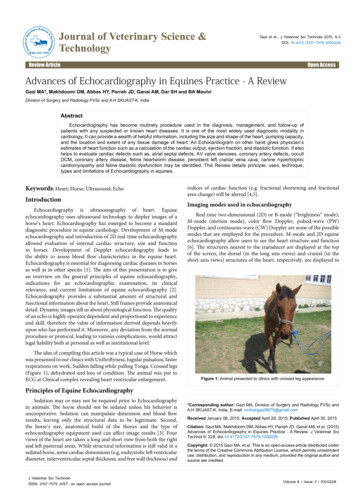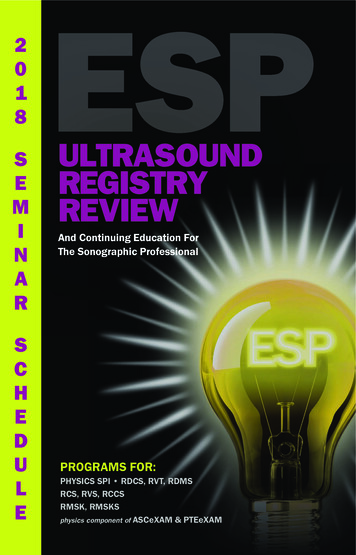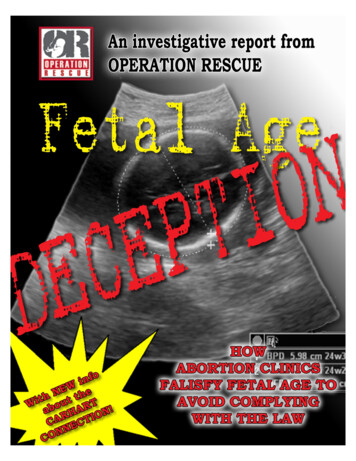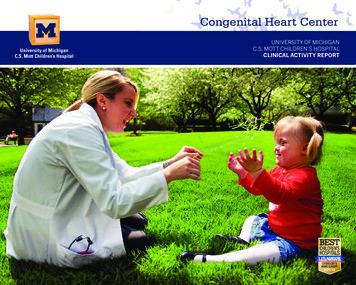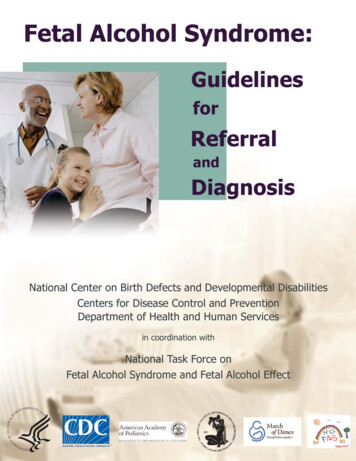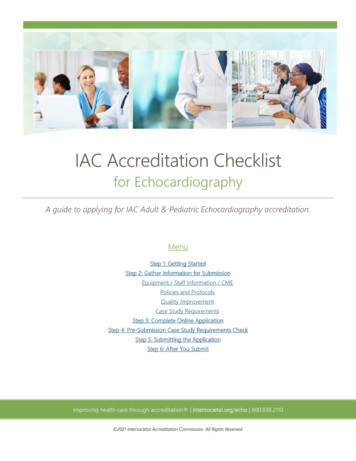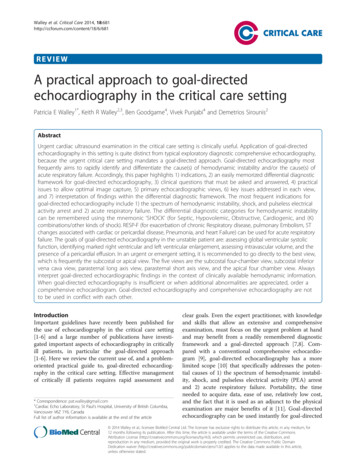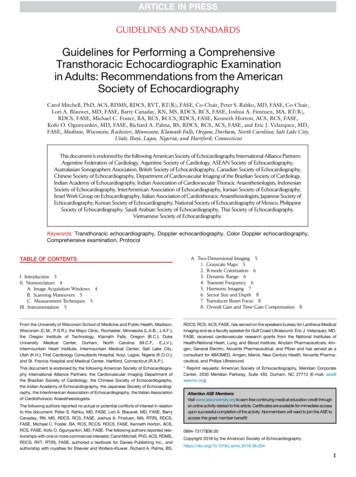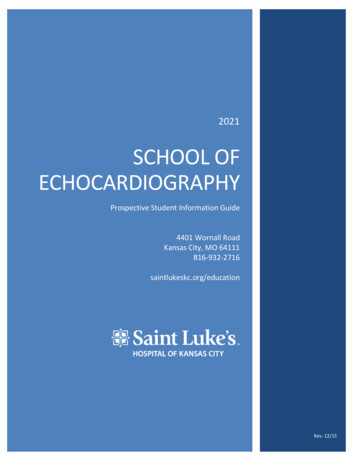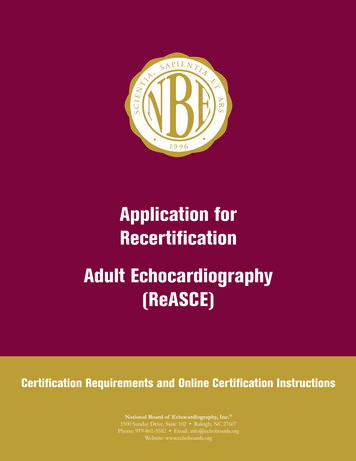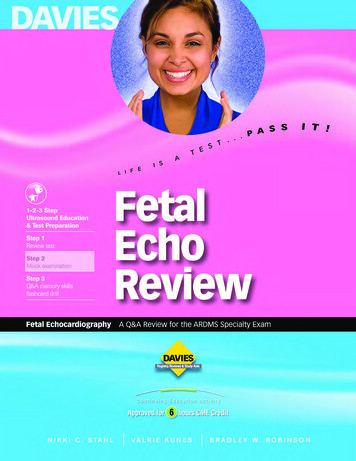
Transcription
Mock Exam Fetal Echo Bk Cvr3/10/101:37 PMPage 1Test yourself before the ARDMS tests you! Fetal Echocardiography Review illuminates thefacts and principles on which you will be tested, hones your test-taking skills, and revealsyour strengths and weaknesses by exam topic. Based precisely on the Fetal Echo specialty exam outline published by ARDMS, this review contains 445 registry-like questions(including CME activity questions) together with answers, clear explanations, and quickreferences for further study. Image-based cases and schematic illustrations prepare youto tackle images, anatomy, and pathology on the exam. Coverage includes embryology,indications, incidence of congenital heart disease, timing of the fetal echo exam, standardsonographic views, normal anatomy and physiology, structural cardiac anomalies, dysrhythmias, acquired pathology, and other conditions—all in the same proportion as theexam itself. Fetal Echocardiography Review is very effective in combination withUltrasound Physics Review: SPI Edition, by Cindy A. Owen, RT, RDMS, RVT, FSDMS,and James A. Zagzebski, PhD. Why are the Davies mock exams so popular and effective? Because they contain the same kinds of thought-provoking questions you will findon the exam! Fetal Echocardiography Review is also a very handy reference for fellowsand residents in pediatric cardiology, maternal fetal medicine, radiology, obstetrics, andperinatalogy. Approved for 6 hours of continuing medical education credit.About the authors . . .Nikki Stahl specializes in high-risk obstetrics and fetal echocardiography atMaternal Fetal Medicine of Central Pennsylvania, where she teaches fellows inthe maternal fetal medicine program. She holds ARDMS credentials in fetalechocardiography, ob/gyn, vascular technology, and abdomen, as well asNTQR nuchal translucency certification and ARRT credentials in diagnostic radiology, CT, and mammography.Valrie Kunes has been teaching and practicing clinical sonography for 25years, specializing in high-risk obstetrics and fetal echocardiography for morethan 12 years. She is past president of the Southeast Florida UltrasoundSociety, and former clinical instructor at Broward Community College, whereshe also served on the college’s Ultrasound Advisory Board. She now practices clinically in Pennsylvania and teaches fellows in maternal fetal medicine.Dr. Robinson is Associate Professor of Pediatrics at Thomas JeffersonMedical College in Philadelphia, and pediatric cardiologist at NemoursCardiac Center at A. I. DuPont Hospital for Children in Wilmington,Delaware. A Fellow of both the American College of Cardiology and theAmerican Academy of Pediatrics, he is the author of numerous original articles, presentations, and book chapters.The New CD-ROM Mock Exams from Davies are the most effective andfeaturesome CDs available. Interactive, fun, and packed with regularly updated peer-reviewedcontent for SPI, Abdomen, Vascular, Ob/Gyn, Breast, and Fetal Echo. Work in Test Mode orStudy & Learn Mode and easily customize your Test and Study sessions to focus on specificexam topics. Hundreds of continuously variable questions and images in registry format.Clear, simple explanations and current references. Expert tutorials on key concepts. Additionalexplanatory images. Test timer keeps you on track. Instant results analysis scores andguides you topic by topic. Automatically review missed questions with one click. AvailableCME credit. A snap to use. Order toll-free 1-877-792-0005 or download from our website.ISBN 0-941022-76-5www.DaviesPublishing.comDAVIESFetal Echocardiography Review
Fetal Echocardiography ReviewA Q&A REVIEW FOR THE ARDMS EXAM
Fetal Echocardiography ReviewiiiFetal EchocardiographyA Q&A REVIEW FOR THE ARDMS EXAMINATION2014Nikki C. Stahl, RT(R)(M)(CT), RDMS, RVTSonographer in High-Risk Obstetrics and Fetal EchocardiographyMaternal Fetal Medicine of Central PennsylvaniaHalifax, PennsylvaniaValrie Kunes, BA, AS(R), RDMS, RDCS, RVTSonographer in High-Risk Obstetrics and Fetal EchocardiographyMiddleburg, PennsylvaniaBradley W. Robinson, MD, FACCAssociate Professor of PediatricsThomas Jefferson Medical CollegeNemours Cardiac CenterA. I. DuPont Hospital for ChildrenWilmington, Delaware
Fetal Echocardiography Reviewivv Copyright 2010–2014 by Davies Publishing, Inc.All rights reserved. No part of this work may be reproduced, stored in a retrieval system, ortransmitted in any form or by any means, electronic or mechanical, including photocopying,scanning, and recording, without prior written permission from the publisher.Davies Publishing, Inc.32 South Raymond AvenuePasadena, California 91105-1935Phone 626-792-3046Facsimile 626-792-5308e-mail rinted and bound in the United States of AmericaISBN 0-941022-76-5Library of Congress Cataloging-in-Publication DataStahl, Nikki C.Fetal echocardiography review : a Q&A review for the ARDMS examination 2010 / Nikki C. Stahl,Valrie Kunes, Bradley W. Robinson.p. ; cm.Includes bibliographical references.ISBN-13: 978-0-941022-76-7 (pbk.)ISBN-10: 0-941022-76-5 (pbk.)1. Fetal heart--Ultrasonic imaging--Examinations, questions, etc. I.Kunes, Valrie. II. Robinson, Bradley W. III. Title.[DNLM: 1. Fetal Heart--ultrasonography--Examination Questions. 2.Echocardiography--methods--Examination Questions. 3. Fetal Heart--anatomy & histology-Examination Questions. 4. Heart Defects, Congenital--ultrasonography--Examination Questions. 5.Ultrasonography, Prenatal--methods--Examination Questions. WQ 18.2 S781f 2010]RG628.3.E34S73 2010618.3'2075430076--dc222010004886
Fetal Echocardiography ReviewvPrefaceTis a question/answer/reference review of fetalechocardiography for those RDMS and RDCS candidates who plan totake the ARDMS specialty examination in fetal echocardiography.Cardiology fellows and pediatric cardiologists who are learning fetalechocardiography will also find this book very helpful. It is designed as an adjunctto your regular study and as a method to help you determine your strengths andweaknesses so that you can study more effectively. Fetal EchocardiographyReview covers everything on the current ARDMS exam content outline and infact follows that outline, which you will find in Part 14 of this book.HIS MOCK EXAMFacts about Fetal Echocardiography Review:§ It precisely covers and follows the current ARDMS exam outline.§ It focuses exclusively on the Fetal Echo specialty exam to ensurethorough coverage of even the smallest subtopic on the exam. (For theSonography Principles and Instrumentation exam, see Ultrasound PhysicsReview: SPI Edition by Cindy Owen and James Zagzebski.)§ Topics are covered to the same extent as on the exam itself. Subjectheadings include the approximate percentage of the exam that a particulartopic represents so you know the relative importance of each topic andcan study more effectively.§ Fetal Echocardiography Review contains nearly 400 questions, many ofwhich are image-based or otherwise illustrated.§ Explanations are clear and conveniently referenced for fact-checking orfurther study.§ Each section is keyed to the ARDMS exam outline so that you alwaysknow where you are, what you are studying, and how it applies to yourpreparation.§ The ARDMS exam outline and contact information for the ARDMSappears in Part 14 at the end of the book.
Fetal Echocardiography ReviewviFetal Echocardiography Review effectively simulates the content and theexperience of taking the exam. Current ARDMS standards call for approximately170 multiple-choice questions to be answered during a three-hour period. That is,you will have an average time of 1 minute to answer each question. Timing yourpractice sessions according to the number of questions you need to finish willhelp you prepare for the pressure experienced by Fetal Echo candidates takingthis exam. It also helps to ensure that your practice scores accurately reflect yourstrengths and weaknesses so that you study more efficiently and with greaterpurpose in the limited time you can devote to preparation. Because the content ofthis Q&A review is formatted and weighted according to the registry’s outline oftopics and subtopics, you can readily identify those areas on which you shouldconcentrate.ARDMS test results are reported as a “scaled” score that ranges from a minimumof 300 to a maximum of 700. A scaled score of 555 is the passing score (the“passpoint” or “cutoff score” for all ARDMS examinations. The scaled score issimply a conversion of the number of correct answers that also, in part, takes intoaccount the difficulty of a particular question. Google or otherwise search forAngoff scoring method if you want to learn more about scaled scoring. Suffice itto say that it helps to ensure the fairness of the exams and that in the case of allARDMS exams 555 is the minimum passing score.We include below and strongly recommend that you read Taking and PassingYour Exam, by Don Ridgway, RVT, who offers useful tips and practical strategiesfor taking and passing the ARDMS examinations.Finally, you have not only our best wishes for success, but also our admirationfor taking this big and important step in your career.Nikki C. StahlValrie KunesBradley W. RobinsonNikki C. Stahl, RT(R)(M)(CT), RDMS, RVTValrie Kunes, BA, AS(R), RDMS, RDCS, RVTBradley W. Robinson, MD, FACC
Fetal Echocardiography ReviewviiTaking and Passing Your Examby Don Ridgway, RVT Preparing for your Exam . . .Study. And then study some more. Knowing your stuff is the most importantfactor in your success. Start early, set a regular study schedule, and stick to it.Make your schedule specific so you know exactly what to study on a particularday. Write it down. Establish realistic goals so that you don’t build a mountainyou can’t climb.As to what you study, don’t just read aimlessly. Focus your efforts on what youneed to know. Rely on a core group of dependable references, referring to othersas necessary to firm up your understanding of specific topics. Let the ARDMSexam outlines guide you. And use different but complementary study methods—texts, flashcards, and mock exams—to exercise those neural pathways.Ease down on studying the week before. Wind down, reduce stress, buildconfidence, and rest up. Don’t cram! And no studying the night before. You hadyour chance. Watch a movie, relax, go to bed early, and sleep well.Organize your things the night before. Lay out comfortable clothes (includinga sweater or sweatshirt in case the testing center is cold), pencils, your ARDMStest-admission papers, car and house keys, glasses, prescriptions, directions tothe test center, and any other personal items you might need. Be prepared!The Day of Your Exam . . .Eat lightly. You do not want to fall asleep during the exam. Go easy on thecoffee or tea so your bladder doesn’t distract you halfway through the exam.Arrive early. Plan to arrive at the test center early, especially if you haven’t beenthere before. Take directions, including the telephone number of the testingcenter in case you have to make contact en route. You don’t need a wrongofframp adventure.Don Ridgway is the author of Introduction to Vascular Scanning: A Guide for theComplete Beginner and editor of Vascular Technology Review. Don teaches andpractices at Grossmont College and Hospital in El Cajon, California.
Fetal Echocardiography ReviewviiiBe confident. As you wait for the exam to begin, smile, lift both hands, wavethem toward yourself, and say, “Bring it on.”During the Exam . . .Read each question twice before answering. Guess how easy it is to get oneword wrong and misunderstand the whole question.Try to answer the question before looking at the choices. Formulating ananswer before peeking at the possibilities minimizes the distractibility of theincorrect answer choices, which in the test-making business are called—guesswhat!—distractors.Knock off the easy ones first. First answer the questions you feel good about.Then go back for the more difficult items. Next, attack the really tough ones.Taking notes on long or tricky questions often can jog your memory or put thequestion in new light. For questions you just cannot answer with certainty,eliminate the obviously wrong answer choices and then guess.Guessing. Passing the exam depends on the number of correct answers youmake. Because unanswered questions are counted as incorrect, it makes senseto guess when all else fails. The ARDMS itself advises that “it is to thecandidate’s advantage to answer all possible questions.” Guessing aloneimproves your chances of scoring a point from 0 (for an unanswered question) to25% (for randomly picking one of four possible answers). Eliminating answerchoices you know or suspect are wrong further improves your odds of success.By using your knowledge and skill to eliminate two of the four answer choicesbefore guessing, for example, you increase your odds of scoring a point to 50%.Don’t second-guess. The common wisdom is that your first answer is morelikely than revised answers to be correct. Actual studies indicate that when youreturn to a question and change the answer, you’ll probably be wrong. Changean answer only if you’re quite sure you should.Pace yourself; watch the time. Work methodically and quickly to answer thoseyou know, and make your best guesses at the gnarly ones. Leave no questionunanswered.Don’t despair 50 minutes into the exam. At some point you may feel thatthings just aren’t going well. Take 10 seconds to breathe deeply—in for a countof five, out for a count of five. Relax. Recall that you need only about three out of
Fetal Echocardiography Reviewixfour correct answers to pass. If you’ve prepared reasonably well, a passing scoreis attainable even if you feel sweat running down your back.Taking the Exam on Computer . . .Some candidates express concern about taking the registry exam on computer.Most folks find this to be pretty easy; some find it off-putting, at least in prospect.But the computerized exams are quite convenient: You can take the exam atyour convenience (a far cry from the days of one exam per year), you knowwhether or not you passed before you leave the testing center (compare that towaiting weeks and even months, as used to be the case), and you canreschedule the exam after 90 days if you happen not to pass the first time (ratherthan waiting another six months to a year). Another good point: The illustrationsare said to be clearer on computer than in the booklets at a Scantron-type exam.Taking the test by computer is not complicated. The center even gives you atutorial to be sure you know what you need to do. You sit in a carrel with acomputer and answer the multiple-choice questions by pointing and clicking witha mouse. There is a clock on the display letting you know how much time is left.Use it to pace yourself. Scratch paper is available; make liberal use of it.You can mark questions to return for answering later. A display shows whichquestions have not been answered so you can return to them. When you havefinished, you click on “DONE,” and you find out immediately whether you passed.It’s nothing to be afraid of. The principles are the same as those for any exam.Be methodical and keep breathing.Summary . . .Preparing for the exam:§ § § § § § StudyUse flashcardsJoin a study groupWind down a week beforeDon’t cramRelax!
Fetal Echocardiography ReviewThe day of your exam:§ § § § Eat lightly, avoid coffeeArrive earlyTake a sweaterBe confident!During the exam:§ § § § § § § Read each question twiceAnswer the question before looking at the answer choicesAnswer the easy ones firstGuess when necessaryDon’t second-guess your first answersPace yourselfDon’t despairTaking the exam on computer:§ § § § § § Just point and clickTake notesMark and return to the hard questionsUse the on-screen clock to pace yourselfBe methodicalBreathe!x
Fetal Echocardiography ReviewxiContentsPrefaceTaking and Passing Your ExamPART 1Embryology1Timing of heart formationTeratogenic insultsAtrial septal componentsEndocardial cushionD- and l-loopingPART 2Indications4MaternalFetalEnvironmentalPART 3Incidence of Congenital Heart Disease6General populationHeredityChromosomalSyndromesExtracardiac anomaliesPART 4Timing of the Fetal Echocardiographic ExamAmerican Institute of Ultrasound in Medicine StandardsPART 5Standard Sonographic ViewsPosition/situsTwo-dimensional heart viewsDoppler hemodynamicsM-mode1211
Fetal Echocardiography ReviewPART 6xiiNormal Fetal Heart Anatomy31SizeVenous connectionsAtria and septumAtrioventricular valvesVentricles and septumOutflow tractsSemilunar valvesGreat arteriesPericardiumOtherPART 7Normal Fetal Heart Physiology37Heart rateBlood flow and cardiac outputIn-utero shuntsSeries circulationPART 8Structural Heart Anomalies43Cardiac malpositionEnlarged heartVenous abnormalitiesAtria and septumAtrioventricular valvesVentricles and septumSemilunar valvesGreat arteriesPericardiumComplex cardiac anomaliesMiscellaneousPART y79
Fetal Echocardiography ReviewPART 10xiiiAcquired n transfusionIntrauterine growth restrictionDrugsPART 11Miscellaneous88Hydrops fetalisExtracardiac anomaliesSyndromesPART 12Answers, Explanations, and ReferencesPART 13CME ApplicationPART 14ARDMS Examination Outline92142157
Fetal Echocardiography Review1PART 1EmbryologyTiming of heart formationTeratogenic insultsAtrial septal componentsEndocardial cushionD- and l-looping1.The pacemaker of the heart is the:A.B.C.D.E.2.At what gestational age is a fetus most susceptible to teratogen exposure?A.B.C.D.E.3.Pulmonary arteriesDuctal archDefinitive aortaAzygous veinInferior vena cavaAbnormal looping of the heart tube to the left will result in:A.B.C.D.E.5.0–4 weeks4–8 weeks12–16 weeks20–24 weeks30–36 weeksThe fourth aortic arch and common dorsal aorta become the:A.B.C.D.E.4.Bundle of HisPurkinje fibersAtrioventricular nodeSinoatrial nodeCoronary sinusComplete transposition of the great arteriesCorrected transposition of the great arteries (l-ventricular loop)Tetralogy of FallotSitus inversus totalisBoth A and BAt what point in heart development does the fetal heart begin to beat?A. 7–10 daysB. 12–14 daysC. 21–28 days
Fetal Echocardiography ReviewD. 28–35 daysE. 35–48 days6.In the sequence of fetal heart development, embryologically what is last to form?A.B.C.D.E.7.A fully septated fetal heart is achieved by gestational week:A.B.C.D.E.8.Semilunar valvesAtrioventricular valvesMembranous septumBoth A and BAll of the aboveWhat syndrome is thought to be a result of a midline development field defect?A.B.C.D.E.11.Coronary sinusRight atriumLeft atriumRight ventricleLeft ventricleEndocardial cushions are involved in the development of the:A.B.C.D.E.10.4681012Four separate pulmonary veins are formed when the left and right pulmonary veinsare absorbed. The four pulmonary veins then normally enter into the:A.B.C.D.E.9.Bulboventricular loopingSemilunar valvesAtrioventricular valvesCoronary sinusPaired heart tubePolysplenia syndromeAsplenia syndromeIvemark syndromeRight atrial isomerismAll of the aboveThe period of organogenesis occurs between which weeks of gestation?A.B.C.D.E.0–33–64–88–1010–122
Fetal Echocardiography Review12.If the primitive heart tube loops to the right instead of the left, the result would be:A.B.C.D.E.13.The partitioning of the embryonic fetal heart into the chambers of the atria andventricles begins at approximately what gestational day?A.B.C.D.E.14.Normal great artery relationship (d-ventricular loop)Ventricular inversionCorrected transposition of the great arteries (l-ventricular loop)Situs inversusBilateral right-sidednessUnknown16182228Coarctation of the aorta is thought to be the result of:A.B.C.D.E.Aberrant ductal tissueDecreased blood flow through the aortic isthmusFailure of the fourth and sixth aortic arch to connect with the descending aortaA and B onlyAll of the above3
Fetal Echocardiography Review4PART 2IndicationsMaternalFetalEnvironmental15.All of the following are indications for a fetal echocardiography exam EXCEPT:A.B.C.D.E.16.Which of the following maternal condition is not an indication for a fetalechocardiography exam?A.B.C.D.E.17.Maternal diabetesMaternal connective tissue disorderMaternal use of alcoholMaternal hyperphenylalaninemia (phenylketonuria)Maternal hyperthyroidismWhich of the following maternal infections is not an indication for a fetal heartexam?A.B.C.D.E.18.Family history of congenital heart defectHistory of tuberous sclerosisExtracardiac abnormalityEchogenic fociExposure to teratogenic medicationsHuman immunodeficiency virus sNoncardiac fetal anomalies detected on a routine exam may increase the risk for acomplex heart defect in that fetus. Which fetal anomaly, if found in isolation, wouldnot warrant further evaluation with a fetal echocardiography exam?A.B.C.D.E.OmphaloceleGastroschisisRenal agenesisDandy-Walker malformationDiaphragmatic hernia
Fetal Echocardiography Review19.Of the fetal findings listed below, which one would not be an indication for a fetalheart niosBradycardiaIntrauterine growth restrictionA fetal heart rate of 230 bpmMaternal exposure to certain medicinal drugs increases a fetus’ risk for a congenitalheart defect. Which of the following drugs does not increase the risk of a LithiumNifedipineAmphetaminesIf there were a family history of a syndrome, which one would warrant a fetalechocardiography exam?A.B.C.D.E.Marfan syndromeDiGeorge syndromeHolt-Oram syndrome (heart-hand syndrome)A and B onlyAll of the above
Fetal Echocardiography Review vi Fetal Echocardiography Review effectively simulates the content and the experience of taking the exam. Current ARDMS standards call for approximately 170 multiple-choice questions to be answered during a three-hour period. That is, you will have an aver
